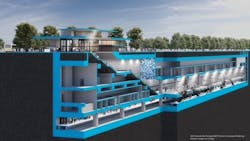Santa Clara VTA releases cost report for tunneling method for BART Silicon Valley Phase II Project
The Santa Clara Valley Transportation Authority (VTA) today released a cost report analyzing the twin bore tunneling method for the BART Silicon Valley Phase II (BSVII) Project. The report, which was developed in response to questions raised by the Santa Clara VTA Board of Directors, provides a clear and transparent look at the costs associated solely with the twin bore approach.
“This report underscores that we are on the right track,” said Santa Clara VTA General Manager and CEO Carolyn Gonot. “The findings reaffirm that the single bore approach remains the most cost-effective method to bring BART service into the heart of Silicon Valley.”
The Santa Clara VTA Board of Directors and the community have consistently supported the single bore design, recognizing its advantages in minimizing community disruption, reducing surface construction impacts and delivering transit more efficiently. According to the agency, key findings of the report highlight higher cost for the twin bore due to the large cut-and-cover stations, challenging construction factors and additional time required for design.
Purpose-driven transparency
Santa Clara VTA notes the newly released report focuses exclusively on the twin bore method, offering an in-depth analysis and view of costs to ensure clarity and transparency for stakeholders and the public. It was commissioned as part of the agency’s ongoing commitment to provide accurate, data-driven information that informs decision-making and builds public trust.
“Our board has raised the question of whether a design change to the twin bore would be cheaper and safer,” said Santa Clara VTA Chief Megaprojects Delivery Officer Tom Maguire. “This report is a direct response to that question. It gives a clear picture of the costs involved with a twin bore tunnel and reinforces why the single bore approach remains the best choice for this project.”
Forward progress
The agency says the analysis took longer than expected and that throughout the review process it continued advancing the BSVII project by pursuing cost containment and cost avoidance strategies that help preserve momentum.
“We’ve been hard at work to keep BSVII on schedule and on budget, and this report validates the strategic decisions that are moving this critical project forward,” Gonot said.
The BSVII Project, which will extend Bay Area Rapid Transit service six miles from the Berryessa/North San José Station through downtown San José to Santa Clara, Calif., is one of the largest infrastructure project in California and the country and is a vital link in the Bay Area’s regional transit network.
The full report can be found on Santa Clara VTA’s website.
